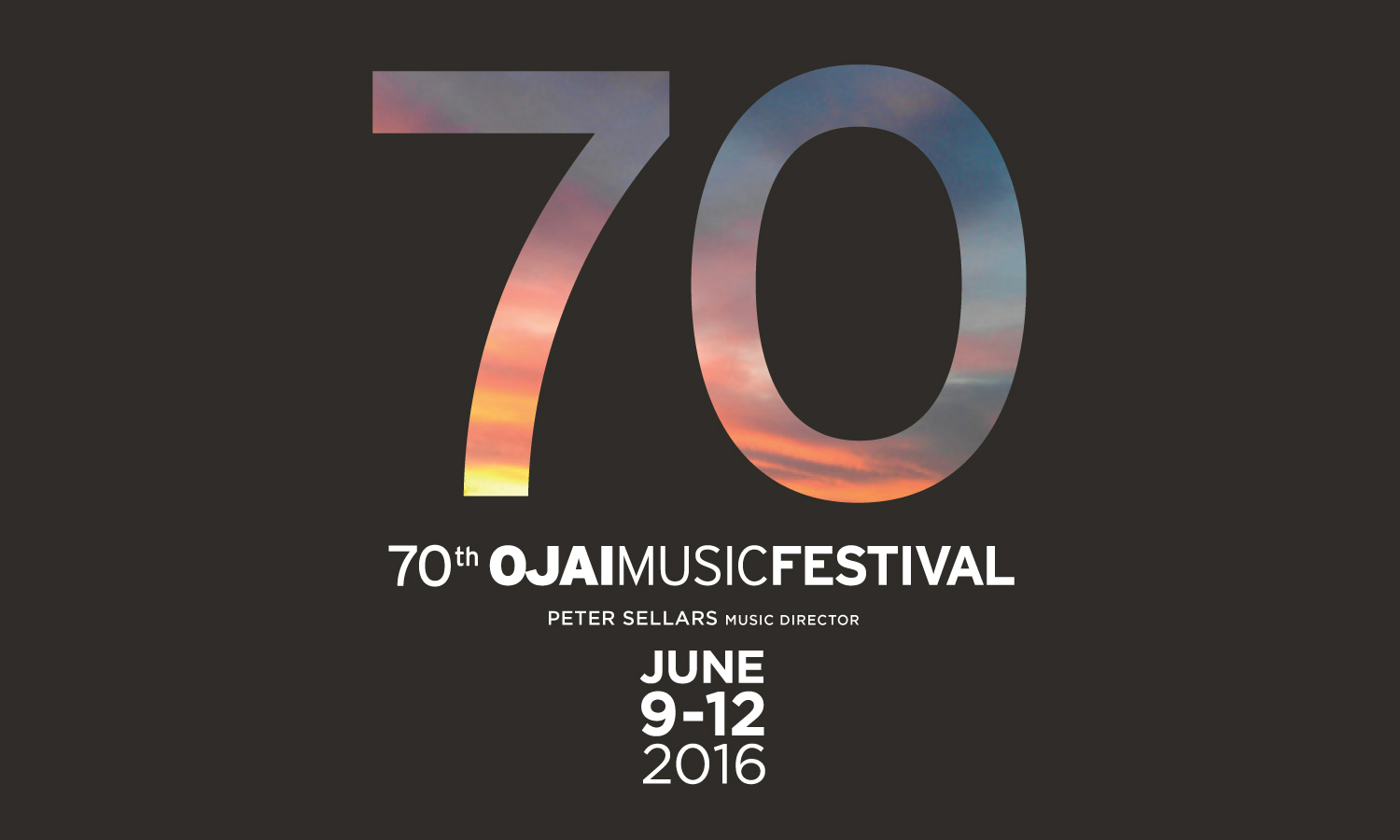2016 Festival Update from Artistic Director Thomas W. Morris
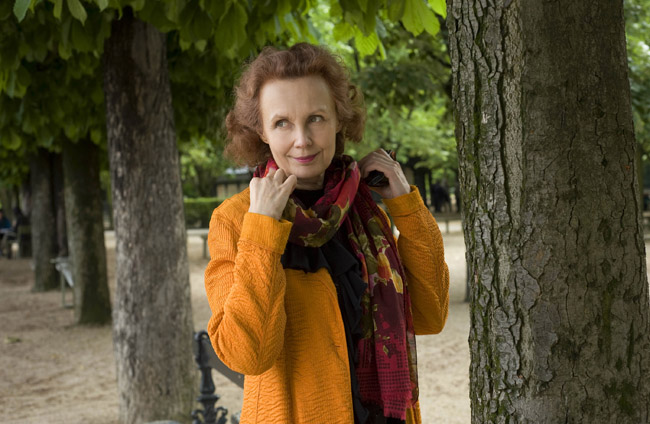
This past week, Artistic Director Thomas W. Morris met with 2016 Music Director Peter Sellars and soprano Julia Bullock as they rehearsed Kaija Saariaho’s La Passion de Simone. He wrote us a brief update on the project, its history, and the plans for Ojai…
Kaija Saariaho’s great work La Passion de Simone was written in 2006 for large symphony orchestra, large chorus and soprano soloist. Its first performances, with Dawn Upshaw, were staged by Peter Sellars in numerous cities around the world. In 2014, Saariaho, as a centerpiece of the Festival Saint-Denis in Paris, made a new version of the piece for an ensemble of nineteen players, a small chorus of four to eight singers, and soprano soloist. The work, conceived as a “Musical Journey in Fifteen Stations”, assumes the form of a contemporary passion play, interpreting the life and thought of the French philosopher Simone Weil. The original libretto by French author Amin Maalouf constitutes the majority of the oratorio’s text, supplemented by spoken fragments from Weil’s work.
Benjamin Champion, composer
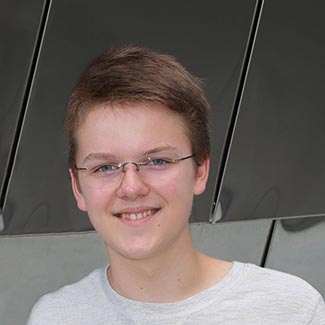
 Benjamin Champion (15) is a sophomore, studying composition and piano at Idyllwild International Arts Academy in Idyllwild, CA. Ben began his piano composition studies in 2011 with his parents, Chris and Sandy Champion. He has also studied piano with Dr. John Walker from SDSU and composition with Kevin Michael Sullivan at Idyllwild. Ben currently studies composition with Mark Carlson of UCLA, and piano with Dr. Jeanette Louise Yaryan, and Parvati Mani at Idyllwild. Under Dr. Walker’s instruction, Benjamin won first place in the 2013 Grant Piano competition and the South Dakota Music Teacher’s Association for piano and composition, Junior Division. In the summer of 2014, Benjamin was chosen to study and perform as a Young Artist at the Dakota Sky International Piano Festival. Here he studied piano with Dr. Paul Tuntland Sanchez, Jacob Ertl, Dr. Gregory DeTurck, Adam Golka, Angelina Gadeliya, and Jon Kimura Parker. Benjamin also attended the Idyllwild Summer Music Camp, where he studied with Dr. Jeanette Yaryan, Parvati Mani, and Doug Ashcraft. In the summer of 2015, Ben returned to the Young Artist program at Dakota Sky International Piano Festival. He studied with Dr. Gregory DeTurk from University of Pennsylvania and Dr. Douglas Humpherys from Eastman. Benjamin has written music for piano, string quartet, vocal and chamber ensembles, and orchestra. Benjamin aspires to pursue music composition at the conservatory level.
Benjamin Champion (15) is a sophomore, studying composition and piano at Idyllwild International Arts Academy in Idyllwild, CA. Ben began his piano composition studies in 2011 with his parents, Chris and Sandy Champion. He has also studied piano with Dr. John Walker from SDSU and composition with Kevin Michael Sullivan at Idyllwild. Ben currently studies composition with Mark Carlson of UCLA, and piano with Dr. Jeanette Louise Yaryan, and Parvati Mani at Idyllwild. Under Dr. Walker’s instruction, Benjamin won first place in the 2013 Grant Piano competition and the South Dakota Music Teacher’s Association for piano and composition, Junior Division. In the summer of 2014, Benjamin was chosen to study and perform as a Young Artist at the Dakota Sky International Piano Festival. Here he studied piano with Dr. Paul Tuntland Sanchez, Jacob Ertl, Dr. Gregory DeTurck, Adam Golka, Angelina Gadeliya, and Jon Kimura Parker. Benjamin also attended the Idyllwild Summer Music Camp, where he studied with Dr. Jeanette Yaryan, Parvati Mani, and Doug Ashcraft. In the summer of 2015, Ben returned to the Young Artist program at Dakota Sky International Piano Festival. He studied with Dr. Gregory DeTurk from University of Pennsylvania and Dr. Douglas Humpherys from Eastman. Benjamin has written music for piano, string quartet, vocal and chamber ensembles, and orchestra. Benjamin aspires to pursue music composition at the conservatory level.
Phyllis Chen, toy pianist and composer

 Phyllis Chen is a pianist, toy pianist, and composer whose musical interests have led in numerous directions as a soloist and collaborative artist. In 2007, Chen founded the UnCaged Toy Piano Composition Competition to encourage composers to write new music for the instrument. Since its inception, the call has received over 200 toy piano pieces from composers around the globe. In 2011, she launched the first biennial UnCaged Toy Piano Festival: three days featuring new works for toy piano and a variety of toy piano performers. Each year the festival has been greeted with great enthusiasm, with audience members crossing state borders and oceans to attend.
Phyllis Chen is a pianist, toy pianist, and composer whose musical interests have led in numerous directions as a soloist and collaborative artist. In 2007, Chen founded the UnCaged Toy Piano Composition Competition to encourage composers to write new music for the instrument. Since its inception, the call has received over 200 toy piano pieces from composers around the globe. In 2011, she launched the first biennial UnCaged Toy Piano Festival: three days featuring new works for toy piano and a variety of toy piano performers. Each year the festival has been greeted with great enthusiasm, with audience members crossing state borders and oceans to attend.
Robby Good, composer
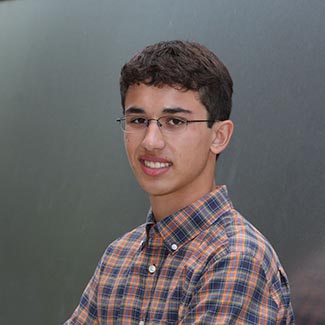
 Robby Good (15) is a sophomore at Hart High School in Santa Clarita. Robby started his musical journey at age 6 with piano lessons, and is currently studying piano with Richard Parizer. He started playing percussion at age 9 and is currently studying under Matt Cook. At 12 years of age, Robby started taking composition, percussion, and ensemble classes at California Institute of the Arts through the Saturday CAP Program. Robby’s first original percussion composition made its debut at the Cal Arts Spring Concert in 2014. In May of 2014, Robby was recognized by Assemblyman Scott Wilk for his dedication to Music Composition. In 2016, he received an honorable mention in the ACF NextNotes High School Composition Awards. While at Hart High, Robby has had the privilege to be a part of the Hart High marching and jazz bands as well as the acclaimed Wind Ensemble under the musical direction of Anthony Bailey. Robby was selected as a percussionist to the 2015 SCSBOA All-Southern High School Honor Symphonic Band. He received a Superior Rating on marimba from the SCSBOA Solo Ensemble. He was also selected to perform in the William S. Hart High School All District Honor Band as a percussionist and pianist under the direction of Professor Sharon Lavery from USC. Robby is a member of the California Scholarship Federation and the National Jr. Honor Society. He currently studies music composition with Professor Ian Krouse of UCLA.
Robby Good (15) is a sophomore at Hart High School in Santa Clarita. Robby started his musical journey at age 6 with piano lessons, and is currently studying piano with Richard Parizer. He started playing percussion at age 9 and is currently studying under Matt Cook. At 12 years of age, Robby started taking composition, percussion, and ensemble classes at California Institute of the Arts through the Saturday CAP Program. Robby’s first original percussion composition made its debut at the Cal Arts Spring Concert in 2014. In May of 2014, Robby was recognized by Assemblyman Scott Wilk for his dedication to Music Composition. In 2016, he received an honorable mention in the ACF NextNotes High School Composition Awards. While at Hart High, Robby has had the privilege to be a part of the Hart High marching and jazz bands as well as the acclaimed Wind Ensemble under the musical direction of Anthony Bailey. Robby was selected as a percussionist to the 2015 SCSBOA All-Southern High School Honor Symphonic Band. He received a Superior Rating on marimba from the SCSBOA Solo Ensemble. He was also selected to perform in the William S. Hart High School All District Honor Band as a percussionist and pianist under the direction of Professor Sharon Lavery from USC. Robby is a member of the California Scholarship Federation and the National Jr. Honor Society. He currently studies music composition with Professor Ian Krouse of UCLA.
Sharon Hurvitz, composer
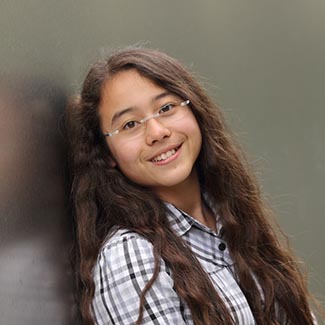
 Sharon Hurvitz (17) has been a Composer Fellow of the LA Philharmonic since 2013. She recently won First Prize in the High School Division of the 2015 Robert Avalon International Competition for Composers, is a Music Composition Honorable Mention Winner (2016) and Merit Winner (2015) of two National YoungArts Foundation Competitions, was a 2014 Finalist in the ASCAP Foundation Morton Gould Young Composer Awards, and a 2015 Finalist in the National Young Composers Challenge. She also was First Place winner two years in a row at the Music Teacher’s Association of California Composers Today State Contest and has been granted its highest accolade for high school and college-age composers, a five-year (2015-2020) honorary membership in The Young Composers Guild. She also was recently commissioned by the Olympia Philharmonic Society for performance by its Youth Orchestra in June 2016. Sharon is a graduate of Yamaha’s International Junior Original Concert Program, where starting at age ten, she performed her own compositions in four U.S. National Yamaha Junior Original Concerts and two National Association of Music Merchants Conventions, including NAMM’s 2012 opening Breakfast of Champions, while studying composition with Yamaha Music Academy Director, Carlton Liu. Now taking piano repertoire lessons with Mark Richman, she has performed in four Celebration of Young Talent Concerts (2 Concerto, 2 Chamber), and numerous other recitals for solo, chamber and piano 4-hands. Sharon also studied violin for 8 years with Chyi-Yau Lee of the Long Beach Symphony Orchestra, and took four years of cello at public schools in San Gabriel, California, where she became Principal Cellist with the Advanced Orchestra and recipient of a 2012 U.S. National School Orchestra Award. She then enrolled in the Classical Piano Department of the Los Angeles County High School for the Arts, where she has won its 2014 and 2015 Awards for Outstanding Achievement in Music – Piano, and is also a 2015 College Board AP Scholar with Honor. Sharon is fluent in Mandarin Chinese, having studied at the Chinese School of San Marino for 8 years.
Sharon Hurvitz (17) has been a Composer Fellow of the LA Philharmonic since 2013. She recently won First Prize in the High School Division of the 2015 Robert Avalon International Competition for Composers, is a Music Composition Honorable Mention Winner (2016) and Merit Winner (2015) of two National YoungArts Foundation Competitions, was a 2014 Finalist in the ASCAP Foundation Morton Gould Young Composer Awards, and a 2015 Finalist in the National Young Composers Challenge. She also was First Place winner two years in a row at the Music Teacher’s Association of California Composers Today State Contest and has been granted its highest accolade for high school and college-age composers, a five-year (2015-2020) honorary membership in The Young Composers Guild. She also was recently commissioned by the Olympia Philharmonic Society for performance by its Youth Orchestra in June 2016. Sharon is a graduate of Yamaha’s International Junior Original Concert Program, where starting at age ten, she performed her own compositions in four U.S. National Yamaha Junior Original Concerts and two National Association of Music Merchants Conventions, including NAMM’s 2012 opening Breakfast of Champions, while studying composition with Yamaha Music Academy Director, Carlton Liu. Now taking piano repertoire lessons with Mark Richman, she has performed in four Celebration of Young Talent Concerts (2 Concerto, 2 Chamber), and numerous other recitals for solo, chamber and piano 4-hands. Sharon also studied violin for 8 years with Chyi-Yau Lee of the Long Beach Symphony Orchestra, and took four years of cello at public schools in San Gabriel, California, where she became Principal Cellist with the Advanced Orchestra and recipient of a 2012 U.S. National School Orchestra Award. She then enrolled in the Classical Piano Department of the Los Angeles County High School for the Arts, where she has won its 2014 and 2015 Awards for Outstanding Achievement in Music – Piano, and is also a 2015 College Board AP Scholar with Honor. Sharon is fluent in Mandarin Chinese, having studied at the Chinese School of San Marino for 8 years.
Carla Kihlstedt
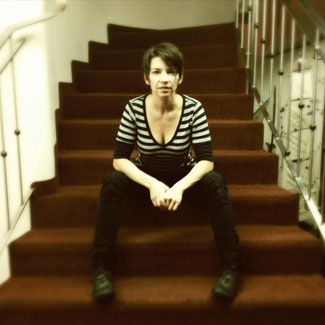
 Though Carla Kihlstedt began her journey with music as a classical violinist, she has become equally committed to the craft of singing, songwriting, composing, and improvising. She is a founding member of a wide variety of ensembles, including Tin Hat, Sleepytime Gorilla Museum, Rabbit Rabbit, The Book of Knots, Minamo, and Fred Frith’s Cosa Brava.
Though Carla Kihlstedt began her journey with music as a classical violinist, she has become equally committed to the craft of singing, songwriting, composing, and improvising. She is a founding member of a wide variety of ensembles, including Tin Hat, Sleepytime Gorilla Museum, Rabbit Rabbit, The Book of Knots, Minamo, and Fred Frith’s Cosa Brava.
Tania León


Tania León is highly regarded as a composer and conductor, and for her accomplishments as an educator and advisor to arts organizations. A founding member of the Dance Theatre of Harlem, León instituted the Brooklyn Philharmonic Community Concert Series and co-founded the Sonidos de las Américas festivals with the American Composers Orchestra. In 2010 she launched the organization “Composers Now” and the month-long Composers Now Festival, celebrating living composers of all genres throughout New York City.
Eric Dudley, conductor

 Through his activities as a conductor, vocalist, pianist, and composer, Eric Dudley enjoys a busy schedule of performances in the United States and abroad. After distinguished tenures as assistant conductor for both the Cincinnati Symphony Orchestra and the Princeton Symphony, he recently appeared as principal conductor for the 2015 Bendigo Festival of Exploratory Music in Australia. Among his latest guest conducting engagements are the National Symphony Orchestra at the Kennedy Center, Hartford Symphony Orchestra (CT), Adelphi Chamber Orchestra (NJ), TENET Vocal Ensemble (NY), Signal Ensemble (NY), International Contemporary Ensemble (ICE), and the Melbourne International Arts Festival. He served for four years on the part-time faculty of Mannes College in New York as director of the Mannes Prep Philharmonic and The New School Chorus, and begins his next appointment as music director of the San Francisco Conservatory Orchestra in the 2016–17 concert season.
Through his activities as a conductor, vocalist, pianist, and composer, Eric Dudley enjoys a busy schedule of performances in the United States and abroad. After distinguished tenures as assistant conductor for both the Cincinnati Symphony Orchestra and the Princeton Symphony, he recently appeared as principal conductor for the 2015 Bendigo Festival of Exploratory Music in Australia. Among his latest guest conducting engagements are the National Symphony Orchestra at the Kennedy Center, Hartford Symphony Orchestra (CT), Adelphi Chamber Orchestra (NJ), TENET Vocal Ensemble (NY), Signal Ensemble (NY), International Contemporary Ensemble (ICE), and the Melbourne International Arts Festival. He served for four years on the part-time faculty of Mannes College in New York as director of the Mannes Prep Philharmonic and The New School Chorus, and begins his next appointment as music director of the San Francisco Conservatory Orchestra in the 2016–17 concert season.
As a founding member of Roomful of Teeth, Dudley is a performer on the group’s 2014 Grammy Award–winning debut album; their latest album, Render, was nominated in the same category in 2016 and includes one of his compositions. For eight seasons, Dudley has also been a tenor in the Grammy-nominated Choir of Trinity Wall Street, where in addition to his role as an ensemble and solo singer, he has prepared the choir for performances at the Brooklyn Academy of Music, performed as a pianist and harpsichordist on Trinity’s chamber series, and served as assistant and guest conductor for a number of the Trinity Choir and Baroque Orchestra’s concert offerings. His own works have received premieres by the Hartford Symphony Orchestra, Roomful of Teeth, Quey Percussion, and through a residency grant from Meet the Composer and the New England Foundation for the Arts. Born in Canada and raised in Connecticut, Dudley received his bachelor’s degree in composition from the Eastman School of Music, and earned master’s and doctorate degrees in orchestral conducting as the recipient of the Dean’s Prize from Yale.
Dina El Wedidi
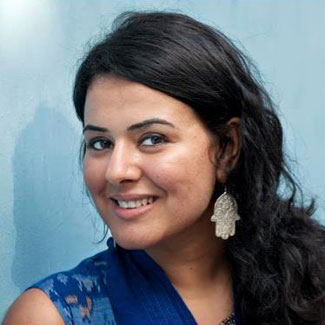
 With her powerful, nuanced voice and authentic style, Egyptian singer and composer Dina El Wedidi (دينا الوديدي) has spent the past six years carving out her place in the Egyptian music scene. While studying oriental languages at the University of Cairo, Dina joined El Warsha Theatre Troupe, exploring Egyptian folklore and performing in such unlikely places as a Cairo prison, and later she performed classical Egyptian and Arabic songs with the Habayebna band. These experiences pushed Dina to sing in many styles, and were the impetus for her to begin composing her own songs. In 2011, she took the fundamental next step and formed her own band; from here her success has soared.
With her powerful, nuanced voice and authentic style, Egyptian singer and composer Dina El Wedidi (دينا الوديدي) has spent the past six years carving out her place in the Egyptian music scene. While studying oriental languages at the University of Cairo, Dina joined El Warsha Theatre Troupe, exploring Egyptian folklore and performing in such unlikely places as a Cairo prison, and later she performed classical Egyptian and Arabic songs with the Habayebna band. These experiences pushed Dina to sing in many styles, and were the impetus for her to begin composing her own songs. In 2011, she took the fundamental next step and formed her own band; from here her success has soared.
Ara Guzelimian, Ojai Talks Director
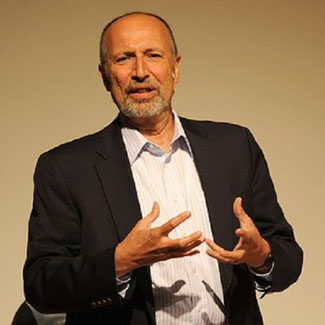
 Provost and dean of The Juilliard School, Ara Guzelimian is the former senior director and artistic advisor to Carnegie Hall and artistic director from 1992 to 1997 of the Ojai Music Festival, where he worked closely with Festival music directors Pierre Boulez, John Adams, Kent Nagano, Michael Tilson Thomas, and Emanuel Ax. Guzelimian also served as artistic administrator of the Aspen Music Festival and was associated with the Los Angeles Philharmonic for 15 years as producer of the orchestra’s national radio broadcasts and as artistic administrator. He has been active as a radio producer and has written for numerous publications. Guzelimian was awarded the title Chevalier des Arts et des Lettres by the French government for his contributions to French music and culture.
Provost and dean of The Juilliard School, Ara Guzelimian is the former senior director and artistic advisor to Carnegie Hall and artistic director from 1992 to 1997 of the Ojai Music Festival, where he worked closely with Festival music directors Pierre Boulez, John Adams, Kent Nagano, Michael Tilson Thomas, and Emanuel Ax. Guzelimian also served as artistic administrator of the Aspen Music Festival and was associated with the Los Angeles Philharmonic for 15 years as producer of the orchestra’s national radio broadcasts and as artistic administrator. He has been active as a radio producer and has written for numerous publications. Guzelimian was awarded the title Chevalier des Arts et des Lettres by the French government for his contributions to French music and culture.
Amin Maalouf, poet

 Born in Beirut in 1949, Amin Maalouf has lived in France since 1976. After studying sociology and economics, Maalouf joined the Lebanese daily An-Nahar, for which he travelled the world covering numerous events, from the fall of the Ethiopian monarchy to the last battle of Saigon. Forced to emigrate by the war in Lebanon, he settled in Paris, where he resumed journalism, and from where he started to travel again, from Mozambique to Iran and from Argentina to the Balkans. He became editor of the international edition of An-Nahar, then editor-in-chief of the weekly Jeune Afrique, before giving up all his posts to dedicate himself to literature.
Born in Beirut in 1949, Amin Maalouf has lived in France since 1976. After studying sociology and economics, Maalouf joined the Lebanese daily An-Nahar, for which he travelled the world covering numerous events, from the fall of the Ethiopian monarchy to the last battle of Saigon. Forced to emigrate by the war in Lebanon, he settled in Paris, where he resumed journalism, and from where he started to travel again, from Mozambique to Iran and from Argentina to the Balkans. He became editor of the international edition of An-Nahar, then editor-in-chief of the weekly Jeune Afrique, before giving up all his posts to dedicate himself to literature.
Luca Mendoza, composer
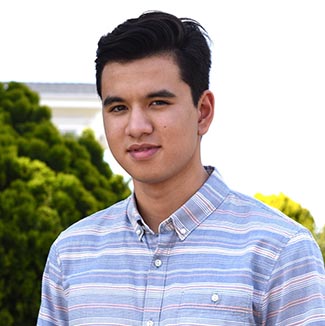
 Luca Mendoza (17) a junior at Crossroads School, studies Jazz piano with Alan Pasqua, classical piano with Rina Dokshitsky and plays in Lee Secard’s Colburn Jazz ensembles and Evan Avery’s Crossroads A Band. Luca is the 2016 National YoungArts Finalist for Jazz piano and Merit Jazz composition winner. Also this year, Luca won the Jazz performance LA Music Center Spotlight Award after being the Honorable Mention Spotlight recipient in 2015. He received an Outstanding Solo Award at the Monterey NextGen Jazz Festival and four Downbeat Magazine Student Music Awards for composition. He has been chosen for the 2016 Monterey NextGen Jazz Orchestra, and was a participant in the Vail Jazz Workshop and Brubeck Jazz Colony. Luca has also been a part of the Colburn Musical Encounters for five years, fostering music education throughout Los Angeles inner city schools. His other awards include first or honorable mentions in the Southwest Youth Music Festival and Glendale classical competitions as well as a solo award and first place in the Fullerton Jazz Festival. He has also recently performed at the Panama Jazz Festival and chamber music with the Elizabeth Mandell Music Institute during a live radio broadcast.
Luca Mendoza (17) a junior at Crossroads School, studies Jazz piano with Alan Pasqua, classical piano with Rina Dokshitsky and plays in Lee Secard’s Colburn Jazz ensembles and Evan Avery’s Crossroads A Band. Luca is the 2016 National YoungArts Finalist for Jazz piano and Merit Jazz composition winner. Also this year, Luca won the Jazz performance LA Music Center Spotlight Award after being the Honorable Mention Spotlight recipient in 2015. He received an Outstanding Solo Award at the Monterey NextGen Jazz Festival and four Downbeat Magazine Student Music Awards for composition. He has been chosen for the 2016 Monterey NextGen Jazz Orchestra, and was a participant in the Vail Jazz Workshop and Brubeck Jazz Colony. Luca has also been a part of the Colburn Musical Encounters for five years, fostering music education throughout Los Angeles inner city schools. His other awards include first or honorable mentions in the Southwest Youth Music Festival and Glendale classical competitions as well as a solo award and first place in the Fullerton Jazz Festival. He has also recently performed at the Panama Jazz Festival and chamber music with the Elizabeth Mandell Music Institute during a live radio broadcast.
Andrew Moses, composer
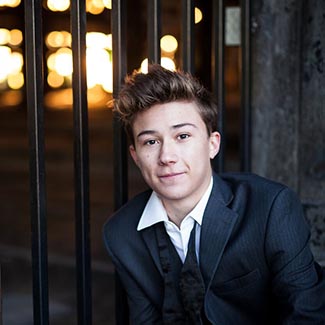
 Andrew Moses (17) is a composer and clarinetist from Los Angeles. Hailed at age 13 as “an artist to watch” and “a musician of enormous talent”, his compositions have been performed, premiered, and read by groups such as the Los Angeles Philharmonic, the Calder Quartet, and the Argus Quartet. Andrew has been a Composer Fellow with LA Phil since 2013, and continues in 2016-2017 as an LA Phil Senior Fellow. His chamber works have been performed in concert as part of the 2015 Hear Now Festival of New Music in Los Angeles, by wild Up at the Regent Theater as part of the LA Phil’s “Next on Grand” Festival, as part of the Yellow Barn Young Artists Program in Vermont, and in readings by the Los Angeles Master Chorale and Los Angeles Philharmonic Chamber Ensembles. The LA Phil premiered two short symphonic works of his at Walt Disney Concert Hall in the past two seasons. Upcoming projects include a commission by the LA Phil for their groundbreaking Green Umbrella new music series to be premiered in October and conducted by John Adams. He has participated in masterclasses with composers such as Kaija Saariaho, John Corigliano, Magnus Lindberg, Christopher Theofanidis, and Esa-Pekka Salonen; and he is currently a student of Andrew Norman. As a clarinet student of Dr. Margaret Thornhill, Andrew made his solo New York City recital debut last year at the home of Charles and Susan Avery Fischer as part of iPalpiti Musicales. He has been featured twice on From the Top on NPR and is a recipient of From the Top’s Jack Kent Cooke Young Artist Award. He was a winner of the 2014 Young Musicians Foundation National Debut Concerto Competition, the Torrance Symphony Orchestra Concerto Competition, the Beverly Hills Auditions, and the Midland National Young Artist Competition. Andrew has thrice participated in the Yellow Barn Young Artists Festival in Vermont; and he is a Junior of iPalpiti Artists International. Andrew has appeared as a concerto soloist with several area orchestras, having performed as concerto soloist in the Walt Disney Concert Hall at the age of 11. Committed to serving the community through Arts Leadership Initiatives, the California Senate joined in recognizing his contributions to the local arts and presented Andrew with the “Making a Difference Award”. In his spare time, he enjoys taekwondo (he is a third degree black belt), poetry, and his community of faith.
Andrew Moses (17) is a composer and clarinetist from Los Angeles. Hailed at age 13 as “an artist to watch” and “a musician of enormous talent”, his compositions have been performed, premiered, and read by groups such as the Los Angeles Philharmonic, the Calder Quartet, and the Argus Quartet. Andrew has been a Composer Fellow with LA Phil since 2013, and continues in 2016-2017 as an LA Phil Senior Fellow. His chamber works have been performed in concert as part of the 2015 Hear Now Festival of New Music in Los Angeles, by wild Up at the Regent Theater as part of the LA Phil’s “Next on Grand” Festival, as part of the Yellow Barn Young Artists Program in Vermont, and in readings by the Los Angeles Master Chorale and Los Angeles Philharmonic Chamber Ensembles. The LA Phil premiered two short symphonic works of his at Walt Disney Concert Hall in the past two seasons. Upcoming projects include a commission by the LA Phil for their groundbreaking Green Umbrella new music series to be premiered in October and conducted by John Adams. He has participated in masterclasses with composers such as Kaija Saariaho, John Corigliano, Magnus Lindberg, Christopher Theofanidis, and Esa-Pekka Salonen; and he is currently a student of Andrew Norman. As a clarinet student of Dr. Margaret Thornhill, Andrew made his solo New York City recital debut last year at the home of Charles and Susan Avery Fischer as part of iPalpiti Musicales. He has been featured twice on From the Top on NPR and is a recipient of From the Top’s Jack Kent Cooke Young Artist Award. He was a winner of the 2014 Young Musicians Foundation National Debut Concerto Competition, the Torrance Symphony Orchestra Concerto Competition, the Beverly Hills Auditions, and the Midland National Young Artist Competition. Andrew has thrice participated in the Yellow Barn Young Artists Festival in Vermont; and he is a Junior of iPalpiti Artists International. Andrew has appeared as a concerto soloist with several area orchestras, having performed as concerto soloist in the Walt Disney Concert Hall at the age of 11. Committed to serving the community through Arts Leadership Initiatives, the California Senate joined in recognizing his contributions to the local arts and presented Andrew with the “Making a Difference Award”. In his spare time, he enjoys taekwondo (he is a third degree black belt), poetry, and his community of faith.
Pauline Oliveros
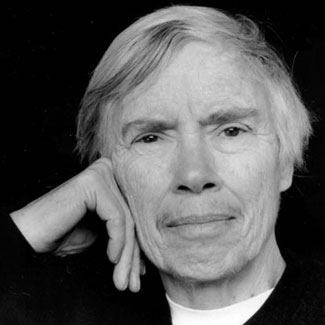
 Pauline Oliveros, composer, performer and humanitarian is an important pioneer in American Music. Acclaimed internationally, for four decades she has explored sound — forging new ground for herself and others.
Pauline Oliveros, composer, performer and humanitarian is an important pioneer in American Music. Acclaimed internationally, for four decades she has explored sound — forging new ground for herself and others.
Through improvisation, electronic music, ritual, teaching and meditation she has created a body of work with such breadth of vision that it profoundly effects those who experience it and eludes many who try to write about it.
Camilla Hoitenga, flute

 Born in Grand Rapids, MI, flutist Camilla Hoitenga studied in the United States, England, and France and eventually made her home in Germany, where she worked several years with Karlheinz Stockhausen. Following her own “path less traveled” she cultivates a repertoire ranging from Bach and Schubert to concertos written for her by Kaija Saariaho, Pèter Koeszeghy or Ken-Ichiro Kobayashi; from Stockhausen’s theatrical Zungenspitzentanz for piccolo to Jean-Baptiste Barrière’s state-of-the-art pieces for live video and electronics to improvisations and recitals with pianist and sound-artist Taavi Kerikmäe. Whether accompanied by orchestras such as the Chicago Symphony or the London Philharmonic or playing alone on stage, Hoitenga captivates her audiences with intense performances, acclaimed by the press as “brilliant,” “alluring,” and “ideally transparent and precise.”
Born in Grand Rapids, MI, flutist Camilla Hoitenga studied in the United States, England, and France and eventually made her home in Germany, where she worked several years with Karlheinz Stockhausen. Following her own “path less traveled” she cultivates a repertoire ranging from Bach and Schubert to concertos written for her by Kaija Saariaho, Pèter Koeszeghy or Ken-Ichiro Kobayashi; from Stockhausen’s theatrical Zungenspitzentanz for piccolo to Jean-Baptiste Barrière’s state-of-the-art pieces for live video and electronics to improvisations and recitals with pianist and sound-artist Taavi Kerikmäe. Whether accompanied by orchestras such as the Chicago Symphony or the London Philharmonic or playing alone on stage, Hoitenga captivates her audiences with intense performances, acclaimed by the press as “brilliant,” “alluring,” and “ideally transparent and precise.”
Los Jornaleros del Norte

 It’s been 15 years since Los Jornaleros del Norte began singing about and for the worker and immigrant community in the United States. It was an immigration raid at a corner of day laborers in the City of Industry, California, which was the impetus for the creation of music and poetry of resistance for them. On that day, a day laborer and musician, Omar Sierra, wrote “El Corrido de Industry” which recounted the events of the raid. This inspired others to share their stories through song and with the help of Pablo Alvarado, founding member and Director of NDLON (National Day Labor Organizing Network), day laborers began to write, sing, and share their struggles and hopes through music and poetry. Since then, they’ve become the soundtrack for the day laborer and immigrant community’s struggle for visibility, inclusion, and equality. Their songs are a historical document of the experiences of the migrant worker community in the United States.
It’s been 15 years since Los Jornaleros del Norte began singing about and for the worker and immigrant community in the United States. It was an immigration raid at a corner of day laborers in the City of Industry, California, which was the impetus for the creation of music and poetry of resistance for them. On that day, a day laborer and musician, Omar Sierra, wrote “El Corrido de Industry” which recounted the events of the raid. This inspired others to share their stories through song and with the help of Pablo Alvarado, founding member and Director of NDLON (National Day Labor Organizing Network), day laborers began to write, sing, and share their struggles and hopes through music and poetry. Since then, they’ve become the soundtrack for the day laborer and immigrant community’s struggle for visibility, inclusion, and equality. Their songs are a historical document of the experiences of the migrant worker community in the United States.
Susan McClary, musicologist
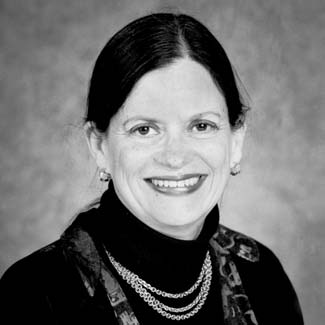
 Dr. Susan McClary (Professor of Music at Case Western Reserve University; Distinguished Professor Emerita, UCLA) focuses her research on the cultural criticism of music. Her books include Feminine Endings: Music, Gender, and Sexuality; Georges Bizet: Carmen; Conventional Wisdom: The Content of Musical Form; Modal Subjectivities: Renaissance Self-Fashioning in the Italian Madrigal; Reading Music; Desire and Pleasure in 17th-Century Music; and Structures of Feeling in 17th-Century Expressive Culture. McClary received a MacArthur Foundation “Genius” Fellowship in 1995, and her work has been translated into at least 20 languages. She is now completing a book titled The Passions of Peter Sellars: The Staging of Music Drama.
Dr. Susan McClary (Professor of Music at Case Western Reserve University; Distinguished Professor Emerita, UCLA) focuses her research on the cultural criticism of music. Her books include Feminine Endings: Music, Gender, and Sexuality; Georges Bizet: Carmen; Conventional Wisdom: The Content of Musical Form; Modal Subjectivities: Renaissance Self-Fashioning in the Italian Madrigal; Reading Music; Desire and Pleasure in 17th-Century Music; and Structures of Feeling in 17th-Century Expressive Culture. McClary received a MacArthur Foundation “Genius” Fellowship in 1995, and her work has been translated into at least 20 languages. She is now completing a book titled The Passions of Peter Sellars: The Staging of Music Drama.
Claudia Rankine, poet
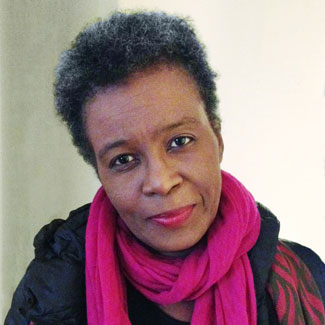
 Claudia Rankine is the author of five collections of poetry including Citizen: An American Lyric and Don’t Let Me Be Lonely; two plays including Provenance of Beauty: A South Bronx Travelogue; numerous video collaborations, and is the editor of several anthologies including The Racial Imaginary: Writers on Race in the Life of the Mind.For her book Citizen, Rankine won both the PEN Open Book Award and the Pen Literary Award, the NAACP Award, and the National Book Critics Circle Award for Poetry. Citizen was the first book ever to be named a finalist in both the poetry and criticism categories and was a finalist for the National Book Award. Citizen also holds the distinction of being the only poetry book to be a New York Times bestseller in the nonfiction category.
Claudia Rankine is the author of five collections of poetry including Citizen: An American Lyric and Don’t Let Me Be Lonely; two plays including Provenance of Beauty: A South Bronx Travelogue; numerous video collaborations, and is the editor of several anthologies including The Racial Imaginary: Writers on Race in the Life of the Mind.For her book Citizen, Rankine won both the PEN Open Book Award and the Pen Literary Award, the NAACP Award, and the National Book Critics Circle Award for Poetry. Citizen was the first book ever to be named a finalist in both the poetry and criticism categories and was a finalist for the National Book Award. Citizen also holds the distinction of being the only poetry book to be a New York Times bestseller in the nonfiction category.
Among her numerous awards and honors, Rankine is the recipient of the Poets & Writers’ Jackson Poetry Prize and fellowships from the Lannan Foundation and the National Endowment of the Arts. She lives in California and is the Aerol Arnold Chair in the University of Southern California English Department.
Roomful of Teeth
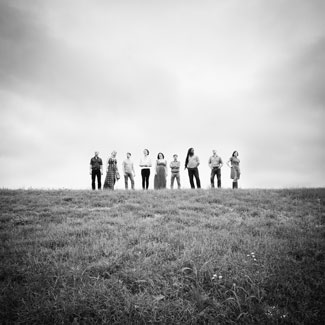
 Roomful of Teeth is a Grammy Award–winning vocal project dedicated to mining the expressive potential of the human voice. Through study with masters from singing traditions the world over, the eight-voice ensemble continually expands its vocabulary of singing techniques and, through an ongoing commissioning process, forges a new repertoire without borders. Founded in 2009 by Brad Wells, the group gathers annually at the Massachusetts Museum of Contemporary Art (MASS MoCA) in North Adams, MA, where they’ve studied Tuvan throat singing, yodeling, belting, Inuit throat singing, Korean P’ansori, Georgian singing, Sardinian cantu a tenore, Hindustani music, and Persian classical singing with some of the world’s top performers and teachers. Commissioned composers include Rinde Eckert, Judd Greenstein, Merrill Garbus (of tUnE-yArDs), Anna Clyne, Fred Hersch, Sarah Kirkland Snider, Michael Harrison, Sam Amidon, and Ted Hearne.
Roomful of Teeth is a Grammy Award–winning vocal project dedicated to mining the expressive potential of the human voice. Through study with masters from singing traditions the world over, the eight-voice ensemble continually expands its vocabulary of singing techniques and, through an ongoing commissioning process, forges a new repertoire without borders. Founded in 2009 by Brad Wells, the group gathers annually at the Massachusetts Museum of Contemporary Art (MASS MoCA) in North Adams, MA, where they’ve studied Tuvan throat singing, yodeling, belting, Inuit throat singing, Korean P’ansori, Georgian singing, Sardinian cantu a tenore, Hindustani music, and Persian classical singing with some of the world’s top performers and teachers. Commissioned composers include Rinde Eckert, Judd Greenstein, Merrill Garbus (of tUnE-yArDs), Anna Clyne, Fred Hersch, Sarah Kirkland Snider, Michael Harrison, Sam Amidon, and Ted Hearne.
Kaija Saariaho
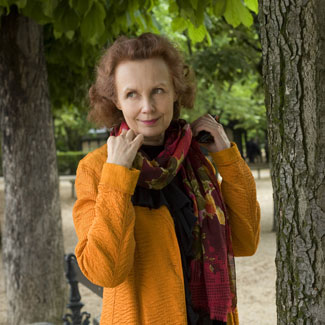
 Kaija Saariaho is a prominent member of a group of Finnish composers and performers who are now, in mid-career, making a worldwide impact. Born in Helsinki in 1952, she studied at the Sibelius Academy there with the pioneering modernist Paavo Heininen and, with Magnus Lindberg and others, she founded the progressive ‘Ears Open’ group. She continued her studies in Freiburg with Brian Ferneyhough and Klaus Huber, at the Darmstadt summer courses, and, from 1982, at the IRCAM research institute in Paris – the city which has been most of the time her home ever since.
Kaija Saariaho is a prominent member of a group of Finnish composers and performers who are now, in mid-career, making a worldwide impact. Born in Helsinki in 1952, she studied at the Sibelius Academy there with the pioneering modernist Paavo Heininen and, with Magnus Lindberg and others, she founded the progressive ‘Ears Open’ group. She continued her studies in Freiburg with Brian Ferneyhough and Klaus Huber, at the Darmstadt summer courses, and, from 1982, at the IRCAM research institute in Paris – the city which has been most of the time her home ever since.
Caroline Shaw
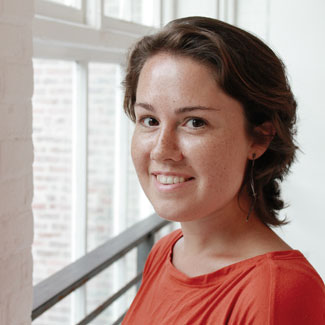
 Caroline Adelaide Shaw is a New York-based musician appearing in many different guises. Trained primarily as a violinist from an early age in North Carolina, she is a Grammy-winning singer in Roomful of Teeth and in 2013 became the youngest ever winner of the Pulitzer Prize for Music, for her enigmatic composition Partita for 8 Voices (also nominated for a Grammy for Best Classical Composition). She will make her solo violin debut in 2015 with the Cincinnati Symphony (MusicNOW).
Caroline Adelaide Shaw is a New York-based musician appearing in many different guises. Trained primarily as a violinist from an early age in North Carolina, she is a Grammy-winning singer in Roomful of Teeth and in 2013 became the youngest ever winner of the Pulitzer Prize for Music, for her enigmatic composition Partita for 8 Voices (also nominated for a Grammy for Best Classical Composition). She will make her solo violin debut in 2015 with the Cincinnati Symphony (MusicNOW).
Christine Southworth, composer
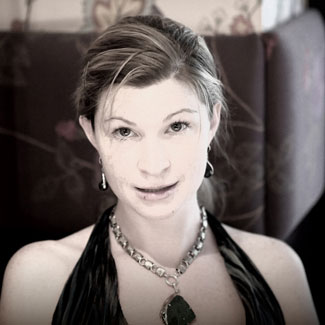
 Christine Southworth (b. 1978) is a composer and video artist based in Lexington, Massachusetts, dedicated to creating art born from a cross-pollination of sonic and visual ideas. Inspired by intersections of technology and art, nature and machines, and musics from cultures around the world, her music employs sounds from man and nature, from Van de Graaff Generators to honeybees, Balinese gamelan to seismic data from volcanoes.
Christine Southworth (b. 1978) is a composer and video artist based in Lexington, Massachusetts, dedicated to creating art born from a cross-pollination of sonic and visual ideas. Inspired by intersections of technology and art, nature and machines, and musics from cultures around the world, her music employs sounds from man and nature, from Van de Graaff Generators to honeybees, Balinese gamelan to seismic data from volcanoes.
Southworth received a B.S. from MIT in 2002 in mathematics and an M.A. in Computer Music & Multimedia Composition from Brown University in 2006. In 2003 she co-founded Ensemble Robot, a collaborative of artists and engineers that design and build musical robots. She is the general manager of the MIT-based Gamelan Galak Tika, and has composed several pieces for the group and performed at venues including Lincoln Center, Carnegie Hall, EMPAC, the Cleveland Museum of Art, several Bang on a Can Marathons, and the Bali International Arts Festival.
Davóne Tines, bass-baritone
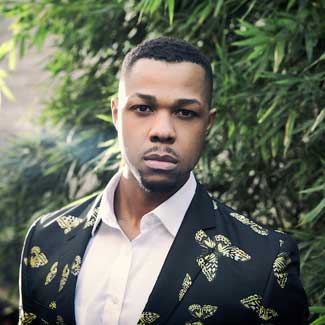
 Davóne Tines, deemed a “… charismatic, full-voiced bass-baritone …” by the New York Times, is building an international career commanding a broad spectrum of opera and concert performance. This past season included appearances with the Boston Pops in Symphony Hall and at Tanglewood, where he was a Tanglewood Music Center Fellow, as well as a debut with the American Repertory Theater in the world premiere of Matthew Aucoin’s opera Crossing, directed by multiple Tony Award–winning director Diane Paulus, for which the Wall Street Journal called him a “glowing bass-baritone” and the Stylus Music Journal said he “… brought the house down with his eloquent and painful singing” in the leading role of Freddie Stowers.
Davóne Tines, deemed a “… charismatic, full-voiced bass-baritone …” by the New York Times, is building an international career commanding a broad spectrum of opera and concert performance. This past season included appearances with the Boston Pops in Symphony Hall and at Tanglewood, where he was a Tanglewood Music Center Fellow, as well as a debut with the American Repertory Theater in the world premiere of Matthew Aucoin’s opera Crossing, directed by multiple Tony Award–winning director Diane Paulus, for which the Wall Street Journal called him a “glowing bass-baritone” and the Stylus Music Journal said he “… brought the house down with his eloquent and painful singing” in the leading role of Freddie Stowers.
Relive the 2015 Festival through our photo gallery
Thank you for joining us for an incredibly memorable week of adventurous music making and community. Relive the moments with our 2015 Festival photo galleries of concerts and scenes from around Libbey Bowl.
2016 Festival
2016 Music Director Peter Sellars
frames programming for 70th Ojai Music Festival
June 9-12, 2016
The Ojai Music Festival marks its 70th year in 2016 and to curate this milestone, Artistic Director Thomas W. Morris has invited opera and theater director Peter Sellars to serve as Music Director. For the 2016 Festival, Peter Sellars is shaping a program deeply rooted in the cultures of Ojai, starting new traditions and setting out fresh agendas for the 70 years to come. The Festival will take place June 9-12, 2016.
As the 69th Ojai Music Festival opens this week (June 10-14, 2015) with Music Director Steven Schick, the Festival’s 2016 Music Director Peter Sellars shares thoughts on his distinctive approach to programming the Festival:

